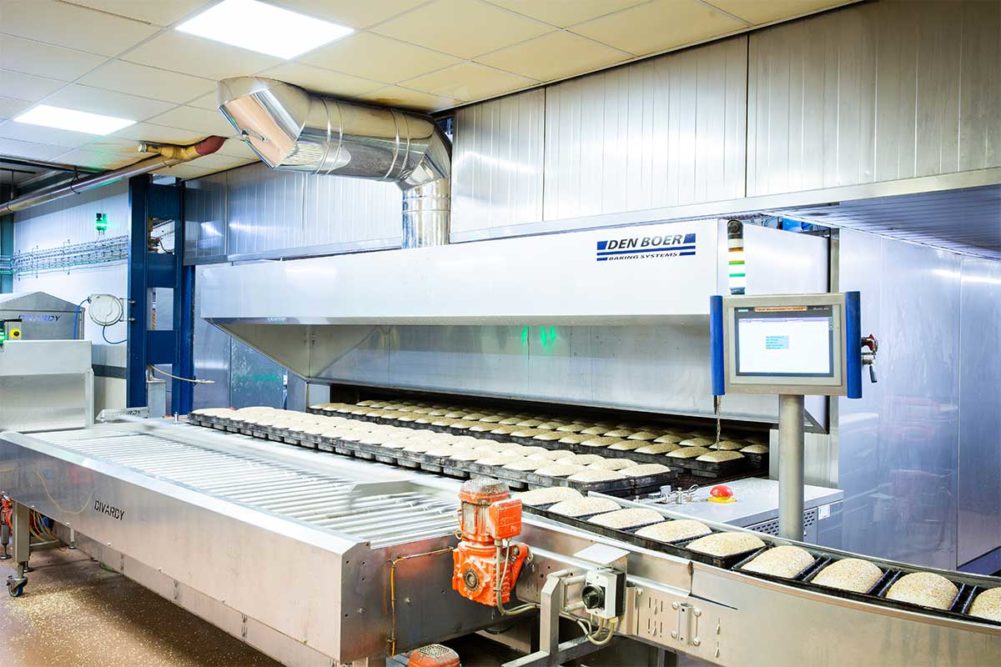Bakeries that invest in electric ovens may have to adjust their process, depending on their product portfolio and the type of oven used.
“Electric heating is a suitable replacement for almost all products if you take into consideration the reduced absolute moisture profile in the baking chamber,” said Phil Domenicucci, baking systems specialist, AMF Bakery Systems.
“In direct-heated natural gas ovens, moisture is a by-product of combustion,” he added. “This moisture is part of the oven baking profile for all products. Since electric heating has no moisture by-products the product baking profile must compensate for the lack of moisture.”
Some systems like convection ovens can use thermal electric heat effectively with little or no impact on products.
“Most baked products that can be run through a modern forced convection tunnel oven can be run without issue using electric power,” said Jerry Barnes, vice president, Babbco. “The core heat transfer methods remain the same, regardless of power source, limiting changes to the bake profile. Concerns about moisture in the bake chamber are largely unfounded, as moisture from the combustion process is a small fraction of the moisture generated in bake-off. Exhaust control becomes the key in this instance.”
Specifically, it’s the heat delivery system of conduction, convection and radiation, not a fuel source like electricity, that determines what’s best for baking specific products, observed Scott McCally, president of McCally, Auto-Bake Serpentine, Hinds-Bock and Inline Filling Systems, all part of Middleby Bakery.
“Throughput also is not impacted by the fuel source,” he said. “All other systems being the same, the product requires the same energy density for baking regardless of the fuel source. Therefore, bakers should not be concerned making this transition.”
Mr. McCally added that electric heating allows for a wide turndown ratio of nearly zero to 100% of the power range of each element and the entire system.
“This provides two very important advantages versus a gas burner,” he explained. “First, a burner at low fire still produces at least 10% and an average of 20% of the burner’s rated output, which produces both wasted energy and runaway heat if the system requires less demand. Second, as a burner modulates, its fuel-to-air ratio changes slightly in transition, which can lead to significant amounts of unburned carbon emissions into the atmosphere.”
In a radiant system, Mr. McCally observed, another advantage is the ability to bake at a higher temperature of up to 900ºF near the product with radiant heat transfer.
Moreover, he said, electric ovens are inherently safer in the highly combustible bakery environment.
He noted there are some limitations. While electric ovens offer a broader range of power and better precision, they do not generally respond to changes in demand as quickly as their gas-fired burner oven counterparts.
“Burners can reach temperatures of 1,800ºF at the flame’s blue tip,” Mr. McCally pointed out. “This is almost double the max temperature of most electric bakery oven elements. Furthermore, the combustion blower drives the burner’s ability to quickly deliver heat from the burner into the system.”
Moreover, he said, electric heating elements are much more susceptible to corrosion and can have as little as 50% of the operational life span of a burner.
“As they corrode their power output also diminishes which will slow their response time and lower their total load capacity,” Mr. McCally said.
Electric ovens aren’t for all bakeries. Many bakers simply prefer the product quality and throughput that they get from direct gas-fired ovens, especially for various types of breads, buns and rolls.
This article is an excerpt from the August 2023 issue of Baking & Snack. To read the entire feature on Ovens, click here.






